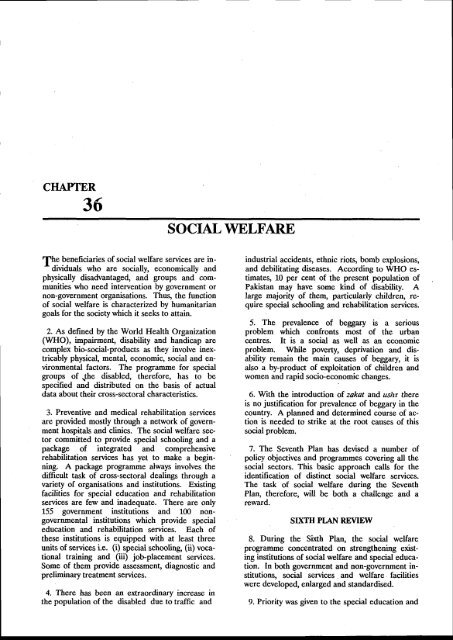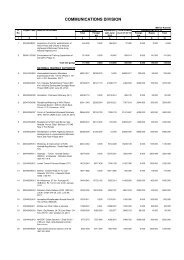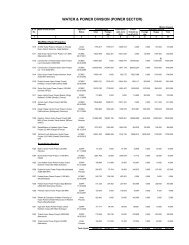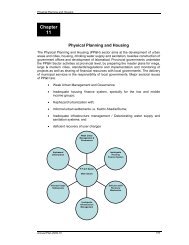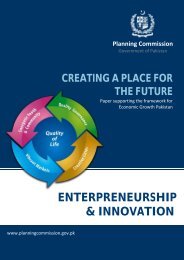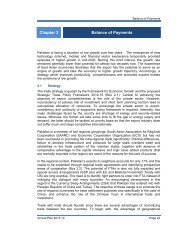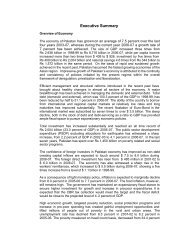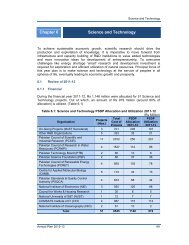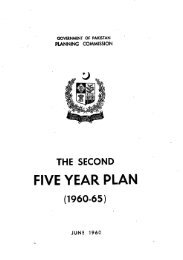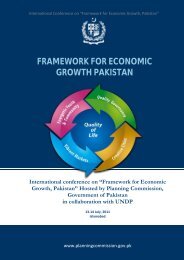Social Welfare
Social Welfare
Social Welfare
Create successful ePaper yourself
Turn your PDF publications into a flip-book with our unique Google optimized e-Paper software.
CHAPTER36SOCIALWBLFAREfhe beneficiaries of social welfare services are in-^ dividuals who are socially, economically andphysically disadvantaged, and groups and communitieswho need intervention by government ornon-government organisations. Thus, the functionof social welfare is characterized by humanitariangoals for the society which it seeks to attain.2. As defined by the World Health Organization(WHO), impairment, disability and handicap arecomplex bio-social-products as they involve inextricablyphysical, mental, economic, social and environmentalfactors. The programme for specialgroups of.the disabled, therefore, has to bespecified and distributed on the basis of actualdata about their cross-sectoral characteristics.3. Preventive and medical rehabilitation servicesare provided mostly through a network of governmenthospitals and clinics. The social welfare sectorcommitted to provide special schooling and apackage of integrated and comprehensiverehabilitation services has yet to make a beginning.A package programme always involves thedifficult task of cross-sectoral dealings through avariety of organisations and institutions. Existingfacilities for special education and rehabilitationservices are few and inadequate. There are only155 government institutions and 100 nongovernmentalinstitutions which provide specialeducation and rehabilitation services. Each ofthese institutions is equipped with at least threeunits of services i.e. (i) special schooling, (ii) vocationaltraining and (iii) job-placement services.Some of them provide assessment, diagnostic andpreliminary treatment services.4. There has been an extraordinary increase inthe population of the disabled due to traffic andindustrial accidents, ethnic riots, bomb explosions,and debilitating diseases. According to WHO estimates,1-0 per cent of the present population ofPakistan may have some kind of disability. Alarge majority of them, particularly children, requirespecial schooling and rehabilitation services.5. The prevalence of beggary is a seriousproblem which confronts most of the urbancentres. It is a social as well as an economicproblem. While poverty, deprivation and disabilityremain the main causes of beggary, it isalso a by-product of exploitation of childrcn andwomen and rapiil socio-economi changes.6. With the introduction of zakat and ushr thereis no justification for prevalence of beggary in thecountry. A planned and determined course of actionis needed to strike at the root causes of thissocial problem.7. The Seventh Plan has devised a number ofpolicy objectives and programmes covering all thesocial sectors. This basic approach calls for theidentification of distinct social welfare services.The task of social welfare during the SevsnthPlan, therefore, will be both a challenge and areward.SIXTH PLAN REVIEW8. During the Sixth Plan, the social welfareprogramme concentrated on strengthgning existinginstitutions of social welfare and special education.In both government and non-government institutions,social services , and welfare facilitieswere developed, enlarged and standardised.9. Priority was given to the special education and
the rehabilitation programmes. However, fundingfor projects in the Public Sector DevelopmentProgramme (PSDP) was less than adequate.Despite this, voluntary social welfare agencies continuedto mobilise private contributions, investmentand zakat funds for expansion and improvementof voluntary social welfare services.10. In the beginning there were some organisationalset-backs in special education. Remedialmeasures were taken in 1985 and a Federal Directorate-Generalof Special Education with provincialcounterparts was set up. The objective was tocoordinate and cooperate with the concernedprovincial departments to accelerate the specialeducation and rehabilitation programme of the disabled.As a result, new development projects forspecial education and rehabilitation of the disabledwere initiated.L1". During the Sixth Plan, the provincial agencieswere constrained by insufficient budgetaryprovisions. Other reasons which slowed downprogress during the Sixth Plan were the lack oftrained personnel and training facilities for professionaland technical manpower, and shortage of institutions,service centres, equipment, tools and appliances.L2. The SiKh Plan made an allocation of Rs 0.6billion (at current prices) for the social welfaresector of which Rs 0.3 billion was allocated to thefederal government. By the end of the Sixh Plan,financial utilization is expected to be 95 per centas given in Statistical Appendix Table 36.1..SEVENTHPLANL3. The Seventh Plan objectives for social welfareare discussed below.OBJECTIVES14. The objectives of the Seventh Plan in thefield of special education and social welfare arethe following:- to develop institutional facilities for specialeducation and vocational training in order tobuild an overall programme of rehabilitationservices to enhance economic and socialfunctioning of the disabled, particularly, disabledchildren;- to develop and strengthen the programme ofexisting social welfare centres through communityorganization and mobilization of localresources including funds from the localzakal committees;- to evaluate, standardise and further promotethe programme of voluntary welfare agenciesthrough Iinancial and technical assistanceand other appropriate measures;- to initiate and develop welfare programmesfor senior citizens which are beneficial andprofitable for them and the community; and- to undertake a re-organisation of the socialwelfare and zakat administration at federal,provincial and local levels to ensure properutilization of. zakat funds for the provision ofsocial services and the revision of VagarancyOrdinance 1958 for control of beggary.15. The welfare programme will give priority todistressed and handicapped children, women and.their families as a whole. in that order.PROGRAMMEi.6. The social welfare programme for theSeventh Plan period is discussecl below.Special Education And Rehabilitation Servicest7. Training Of Special Educatiort Teaclters: TheSeventh Plan proposes to establish 114 additionalinstitutions for special edusation and rehabilitationssrvices. The major programmes are as follows.18. No progress can be made without trained specialeducation teachers and skilled rehabilitationworkers for the disabled. A training programmefor special education teachers and rehabilitationworkers will be designed. The estimated requirementof trained teachers during the Seventh Planperiod is 6,000 for special schools and 10,000 forintegrated ordinary schools. Each provincialgovernment will establish at least one training 4ndone in-service institute. The federal government .will strengthen and upgrade the existing NationalInstitute of Special Education (NISE) with foreigntechnical assistance to train principals of specialschools, heads of institutions for the disabled andmaster trainers. The proposed institute will alsoprovide re-orientation training to special educationteachers through multi-professionalworkshops, seminars and conferences and willcarry out research studies for the improvement ofteaching methods. A sequence of special educa-
SEVENTHPLAN.3OTtion will be started in Universities of the Punjaband Karachi.19. Speciat Schooting: At least one model specialeducation school for each category of the disabledwill be established in each district. The model specialschool will include facilities for special education,vocational 11aining, medical diagnosis, referraltreatment and rehabilitation aids and applian-,ces. NGOs will be encouraged by the federal andthe provincial governments to establish suchschools through provision of technical, financialand equipment assistance.?fr. Integrated E&dation; Integrated education willbe introduced in selected ordinary schools in eachprovince. These ordinary schools will have theprovision of necessary infrastructure in the formofspecial education teachers, equipment, books, avisiting doctor for assessment, diagnosis and treatmentand an administrative mechanism for implementationof an integrated educationprogramme. Special education through ordinary;chools, if successful, *,ill be introduced in eachdistrict of Pakistan.21. Rehabilitation Aids: Provincial special educationand social welfare organisations-will establishadministrative cells in their respective divisionaland district offices to provide rehabilitation aidsto the disabled. The proposed cells will operatein close coordination with divisional and districthospitals. Zakat organisations will be involved forsupportive assistance to this programme.Promotion Of Voluntary Soiial <strong>Welfare</strong> Agencies& Serryices22. Voluntary social work and social welfareagencies have played a major role in the development and provision of social services to the needy.During the last four decades, the number of voluntaryagencies has appreciably increased. Duringthe Seventh Plan period L,550 new NGOs will begiven financial, technical' and professional assis-[ance.Child <strong>Welfare</strong>23. The child welfare programme will have aprominent place in the Seventh Plan. Needy workingas well as school-going children from indigentfamilies will be helped through zakat andrehabilitative measures under the child welfareprogramme. Seven tlpes of child welfare'programmes are proposed, namely: (i) model orphanages,(ii) day care centres for children ofworking mothers, (iii) social service centres forlost and kidnapped children, (w) baby hornes fornew-born babies who are found unclaimed and uncaredfor, (v) mother and child homes to providevocational training and child-care services for indigentmothers with children, (vi) school socialwork units in selected schools with predominanceof children from the low income groups.24. At present, fhere is no programme to provideprotection, care and social services for workingchildren. The federal and the provincial departmentsof social welfare in cooperation with thecentral and the provincial zakat organisations willinitiate and formulate necessary support programmesincluding security assistance to workingchildren after they have been registered. The existinglegislation relating to child labour will bereviewed and amendments made to ensure thatworking children are not exploited bv theiremployers.Medical <strong>Social</strong> Work25. Medical social work units will be establishedin all district and tehsilltalul
cial change at the community level.Staff<strong>Welfare</strong> Senices28. The provision of welfare services andfacilities to employees in any organisation plays avital role in reinforcing efficiency and effectivenessin job performance. The government beingthe largest employer in the country has to providea model to industrial and commercial employersby providing adequate and sufficient staff welfareservices to its employees. The staff welfareprogramme, during the Seventh Plan, will seek to:- Provide vocational training skill developmentand income-earning opportunities forfamily members of government servants;- create facilities which can be helpful to theirfemale members to participate in employment;- undertake schemes to provide recreation,rest and leisure-time activities;- establish multi-purpose community centresto organise community wclfare activitiesthrough organisation and mobilisation ofloca! resources, initiatives and leadership inthe residential areas of governmentemployees;- provide board and lodging facilities toemployees, particularly female employeeswho do not have residential quarters;- establish day-care centres for retirces to"keep them busy and utilise their talenl andexperience for the benefit of their family;- initiate low-cost housing schemes for governmentemployees;- provide stipends and scholarships to school,college, and university-going children ofgovernment employees; and- initiate' other appropriate programmes forthe welfare of government employees andretirees.<strong>Welfare</strong> Of Senior Citizens29. There was no specific programme for seniorcitizens in the previous plans, There has been agradual increase in survivor's rate due to betterhealth. facilities, medical advanccment and improvednutritional status. The population in theage group 60-64 and 65-+ years is around 6.9 percent, being 5.82 million of the total population of84.25 million according to the 1981 census. Thesenior citizens also face numerous problemsresultingfrom rapid socio-economic changes adverselyaffecting the family strubture. During the SeventhPlan, the following programmes will be started:- Day-care centres for senior citizens will beestablished in rnajor cities. The primary objectiveof these day-care centres will be toprovide facilities to elderly persons in orderto keep them busy in activities which ensurethe utilization of their talents, skills and experienceand at the same time are beneficialand profitable both for the aged and the cornmunity;- The ongoing pilo! project of 'Homes for theAged' in the Punjab will be replicated by allprovinces, federal agencies concerned andNGOs. The main objective of such homeswill be to provide institutional care andfacilities for such senior citizrns as are shelterless,homeless and without family support;- The Union Councils ancl Town Committeeswill register and maintain a record of seniorcitizens with regard to their problems, needsand potentialities. Thc local zakat committees,in cooperation with Union Councils/TownCommittees, will sanction monthlyzakat assistance and a one-time zakal grantfor thc poverty-stricken aged. While theprimary objective of monthly zaka, assistancewill be to ensure economic security of elderlypersons within their family structure, the purposeof the grant will be to utilize theirtalents and skills to become self-supporting;- Concessional travel in buses and trains willbe made available for senior citizens onproduction of identity cards as in_case of studentsand journalists; and- <strong>Social</strong> welfare departments will initiateprogramme in cooperation with concerneddepartments for the employment of suitablyqualified senior citizens in "mass literacl'and other such programmes where theirtalents, skills and experience can be utilised.Control Of Beggary30. During the Seventh Plan three types ofprogrammes are proposed to be undertaken tocontrol beggary:- Local bodies in collaboration with - and as-
SEVENTFI PLAN .303sistance of -- local zakat, auqaf, social welfareand tlwna organisations will register beggarsthrough a prescribed proforma whereby.their problems and needs will be assessedand determined. Beggary will be declaredunlawful. However, registered beggars willbe put on the payroll of zakal and skill trainingassistance provided at community level.The zakat organisation with the cooperal.ionof social welfare and other concerned departmentswill be responsible for initiation andorganisation of the proposed programmethroughouthe country;- Beggars who are shelterless, homelcss andwithout family support will be admitted intoDarul Kifala whercin they will be providedfull board and lodging in addition to trainingfacilities in skills. Efforts will be made tomake such beggars self-supporting andproductive members of the socicty; and- Encourage organised charity at communitylevel through the formation of Bait-ul-Mal. ltis proposed to establish community Bait-ul--Mql committees in selected mohallahmosques for the collection and mobilizationr of individual alms and charities. The com-; munity Bait-ul-rnal committees will supplementzakat for beggars at community level.Rehabilitation Centres For Drug Addicts3L. Detoxification programme without rehabilitationservices has very few success stories; relapserate is very high. The new approach which hasbetter chances of the rehabilitation of the drug addictsand reducing relapse rate is to provide vocationaltraining and job-placement facilities alongwith detoxification services. The social wclfaredepartments will establish day'care centres for. vocational rehabilitation of drug addicts.32. Details of benchmark and physical targetsare given in Statistical Appendix Table 36.2.Future Policy Reforms33. One of the basic objectives of the SeventhPlan is the re-organiszation of social welfare andzakat organisations at the federal, provincial andlocal levels. Future policy will ensure that financialorganisations at the federal and provinciallevels confine their role to the collection of zakatonly. Disbursement of zakat assistance to deservingbeneficiaries and the operation of welfareprogrammes under the zakat fund will rest withthe federal and provincial social welfare departm9nts.34. The Central Zakat Administration and NationalZakat Foundation which are under the Ministryof Finance may be placed under the Ministryof Health, Special Education and <strong>Social</strong> <strong>Welfare</strong>to ensure effectivc and adequate utilization ofzakat funds for the wellare of the poor. The socialwelfare departments will ensure thatzakatluslt assistance goes tluough institutionaland organised modalities with appropriate auditing.These government departments will undertakeappropriate measures for identification of thedisadvantaged groups in rural and urban areasprior to the delivery of the welfare inputs underzakatlushr hnds.35. At present, a number of government agenciessuch as National and Provincial Councils of <strong>Social</strong><strong>Welfare</strong>, Literacy and Mass Education Commission,Narcotics Control Board, National ZakatFoundation, Central and Provincial Zakat Administration,Local Zakat Committees, ProvincialAuclaf Departments and Federal Women'sDivision are providing financial and other assistanceto NGOs in a piecemeal fashion. Unlikethc National and Provincial Councils of <strong>Social</strong><strong>Welfare</strong> (which are composed of elected representatives,prominent community leaders, officebearersof NGOs and concerned governmentfunctionaries) the other government organisationsdo not involve NGOs in decision-making. In mostcases they provide financial grants withoutregistration of NGOs by social welfare departments.As a resull of this practice, a number ofbogus NGOs have emerged. Since these NGOsare not registered they seasonally appear and disappearafter receipt of financial grants. The initiativeof genuine and registered NGOs is retardedwhen such bogus NGOs are given equal orprefcrential lreatment. Therefore, there is'needfor a central coordinating body to monitor NGOprogrammes and avoid problems of overlapping,duplication and sub-standard organisation anddelivery of social services. The government willalso evolve a uniform system and lay down standardslor NGOs to receive foreign aid from internationalsources.36. One cause of serious delay in the developmentof special education and rehabilitation services forthe disabled during the Sixth Plan was the lack ofan appropriate and effective administrative set upat national level. The federal government, therefore,will establish and develop a central administrativeframework capable of initiating
304 - SOCIAL WELFARE - (CH-36)programmes for special education and rehabilitationof the disabled. The re-organisation will bein the form of an independent and autonomous'National Trust for the Disabled' which will havethe powers to initiate, approve and execute allprogrammes for social welfare. The federalgovernment will provide seed money for the trustfund which will be anntrally supported by theCentral Zakat Administration and other financialcontributions from government, non-governmentand international donors.Financial Outlay37. The Seventh Plan allocation for social welfaresector is Rs 1 billion. Statistical AppendixTable 36.3 presents details of allocations by subsectorand administrative agencies. In addition tothe Seventh Plan allocations, actual financial expenditurein the sector will depend on adequateand effective utilization of zakat funds through socialwelfare institutions and service centres forrehabilitation of the needy and the poor.


